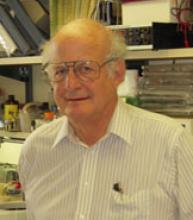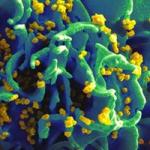
Research Topics
The Viral Pathogenesis and Vaccine Section (VPVS) develops and uses SIV and SIV/HIV chimeric viruses (SHIVs) as surrogates of HIV-1 to investigate virus-induced immunopathogenesis and to develop effective prophylactic vaccines in nonhuman primate models. Toward this end, we have constructed X4- and R5-tropic SHIVs that durably infect macaques and cause systemic depletion of CD4+ T cells in rhesus monkeys, resulting in clinical disease. Recent work has focused on 1) recombination-mediated changes in co-receptor utilization that confer an augmented pathogenic phenotype and 2) the development of cross-reacting neutralizing antibodies directed against the HIV-1 envelope glycoproteins in animals inoculated with the R5-tropic SHIVAD8.
Recent Results
Intermolecular recombination between HIV‑1 strains circulating in an infected individual is now recognized to be a major mechanism involved in the emergence of drug-resistant and immunological escape variants. HIV‑1 recombination has been studied in vivo by inoculating individual rhesus macaques with X4- and R5-tropic SHIVs. In one of the infected monkeys, both SHIVs were potently suppressed by week 12 post-inoculation, but a burst of viremia at week 51 was accompanied by an unrelenting loss of total CD4+ T cells and the development of clinical disease (Fig. 1A). PCR analyses of plasma viral RNA indicated an env gene segment, containing the V3 region from the inoculated X4 SHIV, had been transferred into the genetic background of the input R5 SHIV by intergenomic recombination, creating an X4 virus with novel replicative, serological, and pathogenic properties (Fig. 1B). These results indicate that the effects of retrovirus recombination in vivo can be functionally profound and may even occur when one of the recombination participants is undetectable in the circulation as cell-free virus.
Timeline of recombination events occurring in a rhesus monkey following the inoculation of X4 and R5 SHIVs.Figure 1A
Composition of envelope genes in the plasma virus(es) present following infection.Figure 1B
Figure 1: Timeline of recombination events occurring in a rhesus monkey following the inoculation of X4 and R5 SHIVs. A. Levels of plasma viral RNA and CD4+ T cells in the dually infected animal. B. Composition of envelope genes in the plasma virus(es) present following infection.
An R5-tropic SHIV that causes gradual losses of both memory and naïve CD4+ T lymphocytes, generates anti-viral CD4+ and CD8+ T-cell responses, and generates sustained chronic immune activation while maintaining variable levels of plasma viremia (102 to 105 RNA copies/ml for up to three years post-innoculation) and death from immunodeficiency has been generated (Fig 2).
Plasma Viral Copies / ML Total CD4+ Cells/jul BloodFigure 2: The levels of plasma viremia (a) and absolute numbers of peripheral CD4+ T lymphocytes (b) in rhesus macaques inoculated intravenously with the R5-tropic SHIVAD8.
SHIVs express the HIV envelope glycoprotein and can therefore be used to evaluate HIV-1 Env specific neutralizing antibody (NAb) responses. Developing an SHIV that is capable of eliciting broad and potent NAb responses and tracking the evolution of this immune response might provide unprecedented insight into the factors associated with the development of bNAbs. Plasma from 14 R5-tropic SHIV-infected macaques was therefore screened for the presence of high-titered broadly reacting neutralizing activity, and a single macaque (Rh CE8J) with potent cross-clade plasma NAb response was identified (Fig. 3). Neutralization assays were carried out using samples taken at serial time points and indicated that the development of broad plasma neutralization was unusually rapid and coincided with the development of autologous NAbs. Furthermore, serum mapping studies suggested that the bNAbs interact with carbohydrates and are critically dependent on the N332 glycan (Fig. 4).
Development of potent broadly cross-clade neutralizing antibodies directed against heterologous HIV-1 strains by a macaque (Rh CE8J) inoculated with the R5-tropic SHIVAD8.Figure 3: Development of potent broadly cross-clade neutralizing antibodies directed against heterologous HIV-1 strains by a macaque (Rh CE8J) inoculated with the R5-tropic SHIVAD8. Titers in each cell are color coded as follows: gray, IC50 <1:100; green, 1:100< IC50 <1:300; yellow, 1:300< IC50 <1:500; orange, 1:500< IC50 <1:1000; red, IC50 >1:1000.
The cross-reacting anti-HIV-1 neutralizing activity generated in macaque CE8J is directed against the gp120 N332 glycan epitope.Figure 4: The cross-reacting anti-HIV-1 neutralizing activity generated in macaque CE8J is directed against the gp120 N332 glycan epitope. Plasma samples collected at serial time points were tested for neutralizing activity against JR-CSF, MGRM-C26, and SHIVAD8 pseudovirus variants containing an N332A mutation. Cells are color coded as follows: gray, IC50 <1:100; green, 1:100< IC50 <1:300; yellow, 1:300< IC50 <1:600; orange, 1:600< IC50 <1:1000; red, IC50 >1:1000.
Biography
Dr. Martin received an M.D. from Yale University School of Medicine in 1962 and, following two years of clinical training in internal medicine at the University of Rochester, joined NIH as a research associate. He initially investigated the replication and gene regulation of SV40 and polyomaviruses and subsequently studied endogenous murine and human retroviral sequences. Since 1984, his research program has focused on HIV. Dr. Martin was appointed chief of the Laboratory of Molecular Microbiology when it was established in 1981. He is a member of the National Academy of Sciences and the recipient of numerous scientific awards.
Memberships
- Elected to The National Academy of Sciences, 1998
- Elected to The American Academy of Microbiology, 1998
- ISI Highly Cited Researcher
Editorial Boards
- Journal of Virology
- Associate Editor, Fields Virology, Fourth, Fifth and Sixth Editions, 2001-2012
- Scientific Advisory Committee, New England Regional Primate Center
Selected Publications
- Shingai M, Nishimura Y, Klein F, Mouquet H, Donau OK, Plishka R, Buckler-White A, Seaman M, Piatak M Jr, Lifson JD, Dimitrov DS, Nussenzweig MC, Martin MA. Antibody-mediated immunotherapy of macaques chronically infected with SHIV suppresses viraemia. Nature. 2013;503(7475):277-80.
- Gautam R, Nishimura Y, Pegu A, Nason MC, Klein F, Gazumyan A, Golijanin J, Buckler-White A, Sadjadpour R, Wang K, Mankoff Z, Schmidt SD, Lifson JD, Mascola JR, Nussenzweig MC, Martin MA. A single injection of anti-HIV-1 antibodies protects against repeated SHIV challenges. Nature. 2016;533(7601):105-109.
- Nishimura Y, Gautam R, Chun TW, Sadjadpour R, Foulds KE, Shingai M, Klein F, Gazumyan A, Golijanin J, Donaldson M, Donau OK, Plishka RJ, Buckler-White A, Seaman MS, Lifson JD, Koup RA, Fauci AS, Nussenzweig MC, Martin MA. Early antibody therapy can induce long-lasting immunity to SHIV. Nature. 2017;543(7646):559-563.
- Gautam R, Nishimura Y, Gaughan N, Gazumyan A, Schoofs T, Buckler-White A, Seaman MS, Swihart BJ, Follmann DA, Nussenzweig MC, Martin MA. A single injection of crystallizable fragment domain-modified antibodies elicits durable protection from SHIV infection. Nat Med. 2018;24(5):610-616.
- Escolano A, Gristick HB, Abernathy ME, Merkenschlager J, Gautam R, Oliveira TY, Pai J, West AP Jr, Barnes CO, Cohen AA, Wang H, Golijanin J, Yost D, Keeffe JR, Wang Z, Zhao P, Yao KH, Bauer J, Nogueira L, Gao H, Voll AV, Montefiori DC, Seaman MS, Gazumyan A, Silva M, McGuire AT, Stamatatos L, Irvine DJ, Wells L, Martin MA, Bjorkman PJ, Nussenzweig MC. Immunization expands B cells specific to HIV-1 V3 glycan in mice and macaques. Nature. 2019;570(7762):468-473.
Related Scientific Focus Areas


Microbiology and Infectious Diseases
View additional Principal Investigators in Microbiology and Infectious Diseases

Molecular Biology and Biochemistry
View additional Principal Investigators in Molecular Biology and Biochemistry
This page was last updated on Wednesday, September 18, 2024